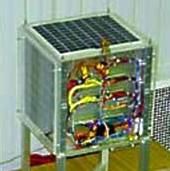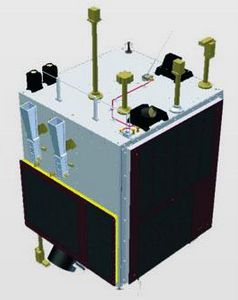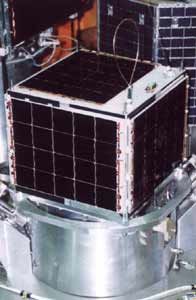
Home - Search - Browse - Alphabetic Index: 0- 1- 2- 3- 4- 5- 6- 7- 8- 9
A- B- C- D- E- F- G- H- I- J- K- L- M- N- O- P- Q- R- S- T- U- V- W- X- Y- Z
Saudisat
 Saudicomsat 1 |
Status: Operational 2000. First Launch: 2000-09-26. Last Launch: 2007-04-17. Number: 7 . Gross mass: 12 kg (26 lb).
Saudisat 1A and 1B were developed by the Saudi Institute for Space Research at KACST (King Abdul-Aziz City for Science and Technology), Riyadh, and carried amateur store-forward communications payloads. A constellation of 24 were to be eventually deployed. Saudisat 2 was completely different, a larger satellite capable of imaging the earth's surface with 15 m resolution.
The Space Research Institute at King Abdul-Aziz City for Science and Technology (KACST)'s SaudiSat-1A and SaudiSat-1B were the first Saudi-built experimental/amateur communication spacecraft's to be constructed and launched by the Saudi Arabia. Each 23 cm cube shaped spacecraft weighed 10 kg and was covered with solar cells on all 6 sides. Six thin gold antennae protrude from the top and bottom of each satellite. Experiments on board included: passive magnetic attitude control experiment, thermal control experiment, solar panels shadowing experiment, broadband UHF antenna experiment, 4 element UHF narrow band circular antenna experiment, multiple analog and digital communication experiments, ranging experiment, digital electronics radiation experiment, single event upset counter experiment, mechanical high power RF relay experiment, and an autonomous self-healing battery charger and regulator experiment. Each SaudiSat consisted of 5 aluminum frames housing its transmitters, receivers, modems, batteries & charger system, computer and memory storage electronics.
From a ground station in Riyadh, Saudi Arabia, nearly 60 channels of telemetry were monitored daily. Initial telemetry indicated very healthy spacecraft, with peak power of nearly 18 watts. Both spacecraft survived three full sun cycles and multiple sun-flare events. Various digital communication experiments provided knowledge in antenna design, interference analysis and power management.
SaudiSat 1A and 1B operated in two modes. The first mode was digital store-and-forward at 9600 baud (Packsat Broadcast Protocol compatible) and the second mode was analog FM repeater (bent pipe.)
Saudi Sat 2 weighted 30 kg and was designed to perform experimental technologies that included taking images with resolution better than 15 m for remote sensing. The orbit was sun synchronous at 700 km. The Saudi Laser Station, part of the Space Research Institute, was to track Saudi Sat 2 with high accuracy.
More at: Saudisat.
| Saudisat 2 Technology satellite built by KACST Space Research Institute, Space Quest for KACST Space Research Institute, Saudi Arabia. Launched 2004. |
| Saudisat 3 Technology, Earth observation satellite for KACST Space Research Institute, Saudi Arabia. Launched 2007. |
| Saudisat 4 Technology demonstration satellite King Abdulaziz City for Science and Technology with a joint NASA Ames payload related to gravitational reference sensors for drag-free spacecraft. |
| Saudisat 5A, 5B Technology, Earth observation satellite for KACST Space Research Institute, Saudi Arabia. |
Family: Amateur radio communications satellite, Communications, Surveillance, Technology. Country: Saudi Arabia. Launch Vehicles: R-36M 15A14, R-36M2 15A18M, Dnepr. Launch Sites: Baikonur, Baikonur LC109. Agency: KACST, Saudi Institute for Space Research. Bibliography: 2, 552, 554.
 | Saudisat 2 Credit: Manufacturer Image |
 | Saudisat 3 Credit: Manufacturer Image |
 | Saudisat 4 Credit: Manufacturer Image |
 | SaudiSat 1A Credit: Manufacturer Image |
 | Saudicomsat 1 Credit: Manufacturer Image |
2000 September 26 - . 10:05 GMT - . Launch Site: Baikonur. Launch Complex: Baikonur LC109. Launch Pad: LC109/95. LV Family: R-36M. Launch Vehicle: Dnepr.
- SaudiSat 1A - . Mass: 10 kg (22 lb). Nation: Saudi Arabia. Agency: Makeyev bureau. Manufacturer: KACST. Class: Communications. Type: Civilian communications satellite. Spacecraft: SaudiSat. USAF Sat Cat: 26548 . COSPAR: 2000-057D. Apogee: 651 km (404 mi). Perigee: 644 km (400 mi). Inclination: 64.56 deg. Period: 97.59 min. Saudisat 1A and 1B were developed by the Saudi Institute for Space Research at KACST (King Abdulaziz City for Science and Technology), Riyadh, and carried amateur store-forward communications payloads..
- SaudiSat 1B - . Mass: 10 kg (22 lb). Nation: Saudi Arabia. Agency: Makeyev bureau. Manufacturer: KACST. Class: Communications. Type: Civilian communications satellite. Spacecraft: SaudiSat. USAF Sat Cat: 26549 . COSPAR: 2000-057E. Apogee: 664 km (413 mi). Perigee: 644 km (400 mi). Inclination: 64.55 deg. Period: 97.73 min. Saudisat 1A and 1B were developed by the Saudi Institute for Space Research at KACST (King Abdulaziz City for Science and Technology), Riyadh, and carried amateur store-forward communications payloads..
2002 December 20 - . 17:00 GMT - . Launch Site: Baikonur. Launch Complex: Baikonur LC109. Launch Pad: LC109/95. LV Family: R-36M. Launch Vehicle: Dnepr.
- SaudiSat 1S - . Payload: SaudiSat 2. Mass: 10 kg (22 lb). Nation: Saudi Arabia. Agency: RSRI. Manufacturer: KACST. Class: Technology. Type: Navigation technology satellite. Spacecraft: SaudiSat. USAF Sat Cat: 27607 . COSPAR: 2002-058C. Apogee: 690 km (420 mi). Perigee: 633 km (393 mi). Inclination: 64.60 deg. Period: 98.00 min. Amateur store-forward communications payload..
2004 June 29 - . 06:30 GMT - . Launch Site: Baikonur. Launch Complex: Baikonur LC109. Launch Pad: LC109/95. LV Family: R-36M. Launch Vehicle: Dnepr.
- Saudicomsat 1 - . Mass: 12 kg (26 lb). Nation: Saudi Arabia. Agency: RSRI. Manufacturer: KACST. Class: Communications. Type: Civilian communications satellite. Spacecraft: SaudiSat. USAF Sat Cat: 28369 . COSPAR: 2004-025D. Apogee: 751 km (466 mi). Perigee: 699 km (434 mi). Inclination: 98.30 deg. Period: 99.30 min. Amateur store-forward communications payload..
- Saudicomsat 2 - . Mass: 12 kg (26 lb). Nation: Saudi Arabia. Agency: RSRI. Manufacturer: KACST. Class: Communications. Type: Civilian communications satellite. Spacecraft: SaudiSat. USAF Sat Cat: 28370 . COSPAR: 2004-025E. Apogee: 783 km (486 mi). Perigee: 698 km (433 mi). Inclination: 98.30 deg. Period: 99.60 min. Amateur store-forward communications payload..
- Saudisat 2 - . Mass: 35 kg (77 lb). Nation: Saudi Arabia. Agency: RSRI. Manufacturer: KACST. Class: Technology. Type: Navigation technology satellite. Spacecraft: SaudiSat. USAF Sat Cat: 28371 . COSPAR: 2004-025F. Apogee: 736 km (457 mi). Perigee: 698 km (433 mi). Inclination: 98.30 deg. Period: 99.10 min. Experimental technology satellite that included imaging with resolution better than 15 m for remote sensing..
2007 April 17 - . 06:46 GMT - . Launch Site: Baikonur. Launch Complex: Baikonur LC109. Launch Pad: LC109/95. LV Family: R-36M. Launch Vehicle: Dnepr.
- Saudisat 3 - . Mass: 35 kg (77 lb). Nation: Saudi Arabia. Agency: RSRI. Class: Surveillance. Type: Military Radarsat. Spacecraft: Saudisat. USAF Sat Cat: 31118 . COSPAR: 2007-012B. Apogee: 679 km (421 mi). Perigee: 656 km (407 mi). Inclination: 98.10 deg. Period: 98.10 min. Saudisat 3 carried a suveillance instrument, backed by data collection and relay avionics, to work in concert with the five smaller SaudiComSats launched at the same time..
2014 June 19 - . 19:11 GMT - . Launch Site: Dombarovskiy. LV Family: R-36M. Launch Vehicle: Dnepr.
- Saudisat 4 - . Mass: 100 kg (220 lb). Nation: Saudi Arabia. Spacecraft Bus: Saudisat. Spacecraft: Saudisat 4. USAF Sat Cat: 40016 . COSPAR: 2014-033G. Apogee: 682 km (423 mi). Perigee: 613 km (380 mi). Inclination: 97.97 deg. Period: 97.67 min. Technology demonstration satellite King Abdulaziz City for Science and Technology with a joint NASA Ames payload related to gravitational reference sensors for drag-free spacecraft..
Back to top of page
Home - Search - Browse - Alphabetic Index: 0- 1- 2- 3- 4- 5- 6- 7- 8- 9
A- B- C- D- E- F- G- H- I- J- K- L- M- N- O- P- Q- R- S- T- U- V- W- X- Y- Z
© 1997-2019 Mark Wade - Contact
© / Conditions for Use